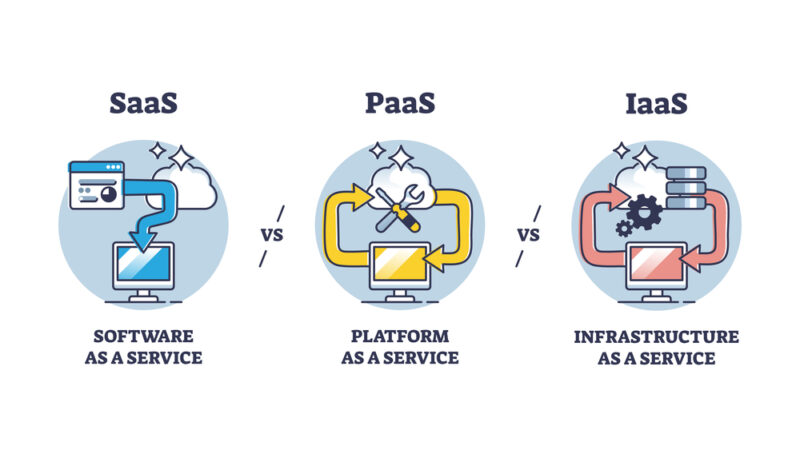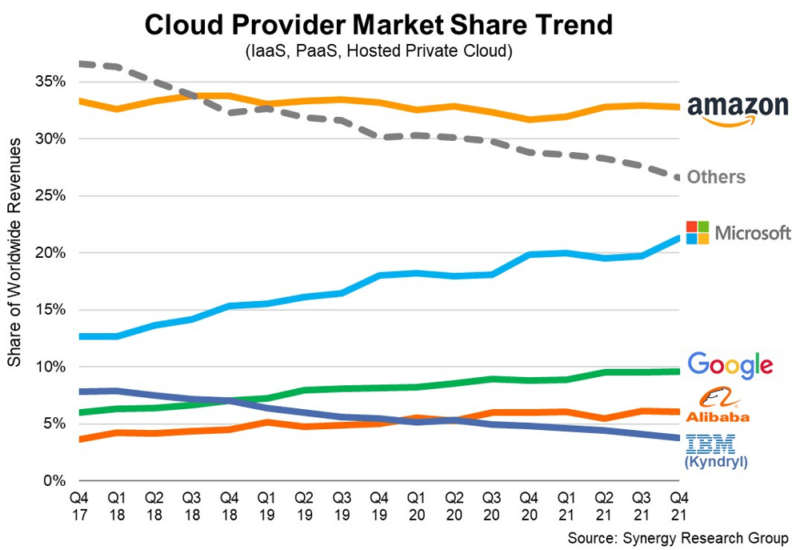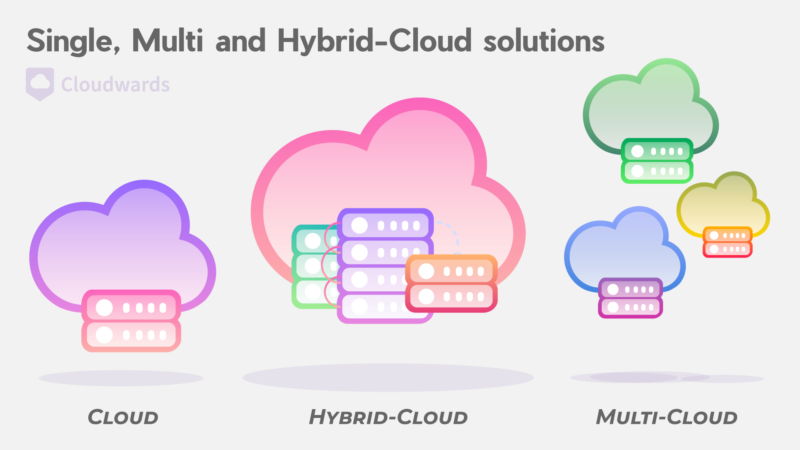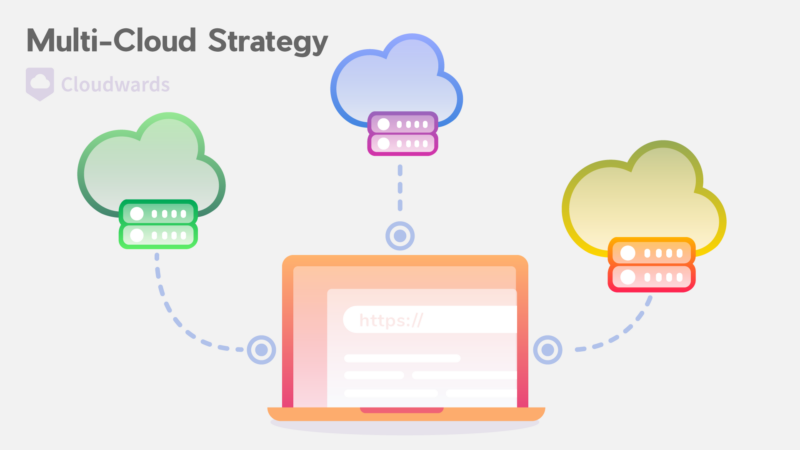37 Cloud Computing Statistics, Facts & Trends for 2025
Cloud computing and services continue to impact how we engage personally and professionally in our increasingly digital world. We compiled 36 of the most amazing and interesting cloud computing statistics illustrating how much the cloud is a part of our lives.
Key Cloud Computing Statistics:
- Amazon AWS accounted for 30% of cloud share in Q4 of 2024.31
- Cybercrimes cost an average of $4.35 million in 2022 for data breaches.20
- Artificial intelligence will impact the global economy by $15.7 trillion by 2030.14
The cloud was a nebulous idea not long ago, reserved for those heavily involved in the tech community. Today, it is a mainstream reality, leveraged by people from every corner of the globe. To illustrate this point, we’ve compiled a list of cloud computing statistics demonstrating how ingrained it is in our lives.
If you engage with the internet in some form, you’ve interacted with a cloud-based product or service. Whether you use cloud computing for personal or professional purposes, the trends on our list of statistics may surprise you.
-
01/22/2024
This article was rewritten to capture current data, trends and statistics.
-
11/18/2024
Updated article with important key takeaways.
-
04/16/2025 Facts checked
This article was updated with new data and statistics for 2024.
Global Cloud Computing Market Statistics
Providing cloud computing services is a big business that has grown rapidly in recent years. It is common to find providers that offer Software-as-a-Service (SaaS), Infrastructure-as-a-Service (IaaS) or Platform-as-a-Service (PaaS). Consumers have plenty of choices, but a few common names top the list.

1. Cloud Infrastructure Services Costs Grew 22% in 2024
Cloud infrastructure usage and adoption by commercial and private users continue to increase. Cloud infrastructure services expenditure totaled $91 billion in Q4 2024, representing a year-over-year growth of 22% compared to Q4 2023. The report indicates AI as one of the primary drivers.31
- Expenditures in Q4 2024 grew $17B.31
- Cloud infrastructure services generated $330.4 billion per year in revenue in 2024.31
Worldwide Cloud Infrastructure Market Share, 2024
2. Cloud Infrastructure Services Average $178B in Annual Revenue
Synergy reports that total year spending on cloud infrastructure services created $178 billion in revenue combined. Specifically in Q4, Synergy “estimates that quarterly infrastructure service revenues (including IaaS, PaaS, and hosted private cloud solutions) were $50.5 billion…”10
- The $178 billion in revenue is up 37% from 2020.10
- Microsoft, Google and Alibaba grew at a greater pace than Amazon.10
3. AWS Spends the Largest Market Share
Amazon AWS is the market leader in total cloud spending with a 32% market share. Microsoft Azure is its closest competitor, owning a 23% market share. However, in 2022, AWS grew 20%, which is its lowest annual growth rate to date.1

4. Microsoft Azure has Grown 8% Since 2018
From Q4 2021 to Q4 2022, Microsoft saw its cloud market grow 2% for an overall market share of 23% worldwide. Since 2018, Microsoft’s market share has increased 8%.10
5. Total Cloud Storage Data to Reach 200 Zettabytes
The world stores a lot of data, with total cloud storage expected to reach 200 zettabytes by 2025, according to a report by Arcserve.11 This figure encompasses all data for both public and private IT infrastructure. Data centers, personal computing and the Internet of Things are also included in this projection.
- In 2020, there were 3.5 billion smartphone users.11
- There were over 19 million software developers in 2019.11
6. Mobile Gaming Market is Valued at $108.15B in 2022
The mobile gaming market continues to gain popularity, with a value of $108.15 billion in 2022, according to Facts and Factors. By 2030, the market share is projected to grow to $339.45 billion with a combined annual growth rate (CAGR) of 13.55%12. Check out our online gaming statistics article for more.
Enterprise Cloud Adoption Statistics
Cloud services have expanded beyond the need to store photos and free up disk space. Companies from every sector have adopted cloud-based services and products. Today, it is more common to find a business that uses the cloud than one that does not.
7. Only 11% of Businesses Encrypt Almost All Their Cloud Data
Less than a third of respondents (27%) said they encrypted 41-60% of their corporation data in an external cloud. Additionally, 12% of respondents indicated that 61-80% of corporate data is encrypted with a cloud service.18
- 1% of the survey respondents didn’t use a cloud service.18
- Only 11% used cloud services to store 81-100% of their data.18
8. Large (67%) and Small Companies (38%) Adopted Cloud Services
Fortune Business Insights reports that large and small companies adopted one or more IaaS, SaaS or PaaS cloud services during 2022. Large companies saw an increase of 67%, and smaller companies increased cloud service use by 38%.19
- Businesses attributed the growth to increased remote work due to COVID-19.19
- Small and medium-sized companies are projected to grow at a higher rate.19
In the European Union, 75.3% of enterprises that purchased cloud computing services in 2023 were categorized as “highly dependent” on the cloud, adopting sophisticated cloud services rather than just basic or intermediate solutions.8
Cloud adoption varies significantly by economic sector, with information and communication companies leading at 79% adoption, professional and scientific enterprises at 62.4%, while sectors like manufacturing and construction show adoption rates between 37.6% and 56%, respectively.32
9. 91% of Companies Have Adopted AI Initiatives
Artificial intelligence (AI) continues to grow at a staggering rate. We explore this more specifically in our ChatGPT statistics article and our AI writing statistics article.
According to the Data and AI Leadership Executive survey administered by NewVantage Partners, 91% of companies are investing in AI initiatives with data management.13 Part of the push to adopt AI is the positive results companies see from the investment.
- 92% saw measurable business benefits from AI adoption.13
- The adoption rate was 48.4% in 2017 and 70.3% in 2020.13
10. AI Is Projected to Have a $15.7T Economic Impact by 2030
PwC’s recent Global Artificial Intelligence Study: Exploiting the AI Revolution estimates that AI could contribute $15.7 trillion to the global economy14. If accurate, that number is more than the combined economic impact of China and India.
- More than $6.5 trillion could be found from increased overall productivity.14
- An additional $9.1 trillion could come from consumer consumption.14
11. Multi-Cloud Strategy Gains Popularity
Multi-cloud strategies provide organizations with significant benefits, including vendor negotiation leverage, geographic coverage optimization and risk mitigation against vendor-specific outages and price increases.
Of the nearly 2,800 respondents in the 2022 Thales Data Threat Report: Global Edition, 27% indicated using at least 50 SaaS apps, with a further 16% using 51-100.18
- 53% preferred Amazon Web Services as their IaaS provider.18
- 4% of respondents use up to 500 SaaS apps.18
12. Most Companies Use a Hybrid Cloud Strategy
Businesses have the option to use a public or private cloud service. However, they are increasingly adopting sophisticated enterprise cloud strategies that balance public, private and hybrid models to address specific organizational needs and compliance requirements. Flexera’s 2023 State of the Cloud Report indicates that 71% of companies opt for a hybrid cloud strategy.21
- 4% of companies are private cloud-only.21
- 24% of businesses surveyed did not use private services.21

Cloud Costs & Spending Statistics
Globally, cloud computing costs significantly increased in 2022 as cloud adoption for personal and private use increased. The top three cloud providers, Amazon, Microsoft and Google, dominated the market share as cloud costs became a top priority for businesses.
13. Cloud Computing Market Valued at $545.8B in 2022
According to a report published by Markets and Markets, the total cloud computing market was valued at $545.8 billion in 20224. Some of the drivers of this figure are increased automation, return on investment and the increase in remote work culture.
- By 2027, the number could reach up to $1,240.9 billion.4
- That would put the CAGR over that period at 17.9%.4
14. The Top Three Cloud Providers Comprised 65% of All Spending
Canalys reports that the combined amount spent on Amazon, Microsoft and Google cloud service providers accounted for 65% of the total money spent on cloud infrastructure in 2022. The big three brought in $42.77 billion of the total $65.8 billion spent in 20221.
- Total cloud infrastructure spending grew 29%.1
- The growth rate slowed by 10% from Q1 to Q4 in 2022.1
15. Personal Cloud Storage Worth $20.8B in 2022
The total worth of personal cloud storage was $20.8 billion in 2022, according to a report by Markets and Markets7. Personal cloud is used to store folders, files, photos and music with the ability to share these items with others.
- By 2027, the personal cloud market is projected to grow to $50.8 billion.7
- The CAGR over this time is 19.6%.7
16. Cloud Spending Management a Top Priority
According to a report published by AAG, 82% expressed concerns about managing cloud spending.6 These concerns are not limited to business size, as both enterprises and SMBs consider cloud costs a challenge.
17. AI Spending Expected to Reach $154B Globally
The IDC reports that by the end of 2023, global spending on AI development will be $154 billion. By 2026, the number could increase to $300 billion.22
Generative AI is now driving approximately half of cloud market growth as of 2024, creating a virtuous cycle where new AI capabilities increase demand for cloud services, generating more revenue for cloud providers to invest in advanced technologies.33
18. The Cloud Application Market Is Estimated to Reach $168.6B
By 2025, the global cloud application market is projected to reach $168.6 billion by 2025, according to a study conducted by Apps Run The World.23
Public Cloud Services & Cloud Infrastructure Statistics
Many of the familiar names sprinkled throughout these statistics are the ones that provide cloud infrastructure services. Businesses commonly use IaaS as it helps reduce overhead and upkeep costs. Amazon AWS and Microsoft Azure are the market leaders.
19. IaaS Public Cloud Services Grew 29.7% Globally in 2022
Worldwide, the IaaS market grew by 29.7% in 2022, according to a report by Gartner. “Cloud has been elevated from a technology disruptor to a business disruptor,” said Sid Nag, VP Analyst at Gartner. “IaaS is driving software-as-a-service (SaaS) and platform-as-a-service (PaaS) growth as buyers continue to add more applications to the cloud and modernize existing ones.2
Major cloud providers are also investing heavily in quantum cloud computing capabilities, with estimates suggesting the quantum cloud market will reach $26 billion by 2030 as organizations seek to leverage quantum processing power without massive hardware investments.30
- The top five IaaS providers accounted for over 80% of the market.2
- Amazon and Microsoft were the two industry leaders.2
20. Worldwide Public Cloud Services Grew an Average of 19.9% in 2023
Year over year, worldwide public cloud services revenue grew by 19.9% in 2023, per a report from the International Data Corporation. SaaS is the largest public cloud type, accounting for about 45% of revenue.3
- IaaS accounted for 19.9% of the revenue share.3
- PaaS and SaaS had the lowest percentages, at 18.4% and 17%, respectively.3
In the European Union, 45.2% of enterprises reported buying cloud computing services in 2023, with the highest adoption rates in Finland (78.3%), Sweden (71.6%) and Denmark (69.5%).32
Among these EU enterprises purchasing cloud services, 95.8% use at least one Software-as-a-Service (SaaS) offering, 74.2% utilize Infrastructure as a Service (IaaS) and 26.1% employ Platform-as-a-Service (PaaS) solutions.32
21. Cloud Data Centers Account for 1% of the World’s Energy Consumption
Despite the increased demand for digital services and more people online, overall global energy consumption by data centers was between 1-1.5%.15 One of the reasons outlined by the IEA report includes energy efficiency improvements, which helped keep consumption low.
- Data centers and transmission accounted for 1% of energy-related CO2 emissions.15
- Since 2010, the number of internet users has doubled.15
22. There Are More Than 9,000 Worldwide Data Centers as of 2023
Data centers, which are networks of computing and storage resources that deliver shared applications and data, topped 9,000 worldwide in 2023, according to Statista.5
- By far, the U.S. has the most, with more than 5,300 data centers.5
- Germany and the U.K. have more than 1,000 data centers combined.5
- China has 448 data centers.5
23. The Largest Data Center in the World Is in China
According to Analytics Adrift, China Telecom-Inner Mongolia Information Park is the largest data center in the world at over 10 million square feet. The data center has a 50% share of the Chinese data market.24
- China also has the second largest data center: China Mobile – Hothot Data Center.24
- The third largest data center is Switch-The Citadel Campus in the U.S.24

24. IT Infrastructure Outages Are Decreasing
According to the annual survey by the Uptime Institute, 60% of respondents had suffered an outage in the last three years, which is down from 69% in 2021 and 78% in 2020. Of the outages reported in 2022, 14% were categorized as “severe” or “serious,” which again is down from around 20% in previous years.29
Statistics on Personal Cloud Storage Services
Personal cloud storage is a massive business, with billions of people using cloud storage. Of the many options available, most people prefer Google Drive and Dropbox. Additionally, most personal cloud storage users access their accounts using mobile devices.
25. 2.3 Billion People Use Personal Cloud Storage
In 2020, an estimated 2.3 billion people used personal cloud storage6, according to AAG. Google Drive, iCloud and Dropbox were the most popular cloud storage services.
- Photos are the most popular reason people use cloud storage at 71%.6
- More than half use cloud storage for backup purposes.6
26. Over Half of Personal Cloud Storage Users Have Multiple Cloud Storage Accounts
More than half of personal cloud storage users have multiple accounts. Per a Goodfirms survey, 54.62% of respondents indicated using three different cloud storage platforms. More than 50% of the survey respondents said they used a free or limited cloud storage plan.8
- Over 90% of personal cloud storage users say they are influenced by cloud storage.8
- Google Drive and Dropbox are the most popular choices.8

27. Only 10% of People Use Cloud Storage Desktop Apps
Most cloud storage services have mobile and desktop apps accompanying the web interface. According to a Goodfirms survey, only 10.65% of respondents preferred to use a desktop app.8
- Just over 89% use a mobile app to access their cloud storage account.8
- About 87.96% use the web interface when interacting with their data.8
28. Over 94% of Cloud Storage Users Prefer Google Drive
Google Drive is the most popular personal cloud storage service. According to Goodfirms, 94.44% prefer Google Drive. Dropbox is a distant second at 66.20%.8
- OneDrive and iCloud are at 39% and 38%, respectively.8
- pCloud is preferred by only 1.39% of survey respondents.8
29. Google Drive Has the Most Users
Google Drive surpassed a billion account holders in 2018, making it the most used cloud storage provider25. By now, that number is undoubtedly higher.
Cloud Security Statistics
Cybersecurity continues to be a significant factor in cloud computing management. Data breaches, ransomware and exposed emails are a few of the many ways cybercrime has wide-ranging impacts.
Economically, cybercrimes impact the global economy well into the trillions of dollars. Therefore, it is important to consider container security as a key aspect in mitigating these risks.
However, organizations are increasingly adopting zero-trust security models for cloud environments, which require verification for anyone trying to access resources regardless of their position inside or outside the network perimeter.
30. Cybercrime Costs an Average of $4.35M in 2022
Despite cybersecurity professionals’ best efforts, the average business cost of a data breach was $4.35 million in 2022, per a report by AAG. Additionally, cybercrime impacted the global economy by $7 trillion.20
- 32% of businesses in the U.K. experienced a cyberattack in 2022.20
- In the first half of 2022, an estimated 53.35 million Americans were victims of a cyberattack.20
31. 80% of Businesses Have Experienced At Least One Data Breach
Fortune Business Insights cites a survey conducted by Ermetic Ltd. where 80% of responding businesses had at least one data breach in an 18-month period during 2020.9
However, IT infrastructure outages are decreasing, with 53% of organizations in having experienced an outage in the past three years, down from 60% in 2022 and 69% in 2021, according to the Uptime Institute.34
- 43% of businesses had more than 10 data breaches over the same period.9
- Poor cybersecurity framework is a major risk factor for a data breach.
32. Almost 1 Billion Emails Were Exposed in 2021
Per an AAG report, 1 in 5 internet users were affected by almost 1 billion emails being exposed from cybercrimes like phishing attacks. Phishing attacks cost victims an average of $136.20
33. North Americans Suffered the Most Account Breaches
North Americans were the most likely group to experience an account breach in 2021. AAG reports that one in two people from the North American continent suffered an account breach.20
- Combined, the U.S. and the U.K. had more cybercrime victims per million internet users in the world.20
- The Netherlands has seen a 50% increase in cybercrimes since 2020.20
34. Supply Chain Attacks Increase in Frequency
Due to the interconnected nature of global supply chains, security vulnerabilities present an opportunity for cybercriminals. According to AAG, up to 40% of cybercrimes occur somewhere in a given supply chain.20
- Only 23% of cybersecurity specialists use real-time monitoring of their partners or vendors.20
- Atlassian products present a risk as they are used in more than 190 countries.20
35. Ransomware is the Fastest-Growing Cybercrime
According to a whitepaper published by Arcserve, ransomware is “the most infectious disease known to humankind.” It predicted in 2021 that businesses will be a victim of ransomware every 11 seconds. The cost reaches upwards of $20 billion.11
- In 2019, ransomware attacks on businesses occurred every 14 seconds.11
- Consumer ransomware attacks happen every five seconds.11
36. Greece Owns the Top Score on the NCSI
The National Cyber Security Index measures a country’s readiness to prevent and manage cybersecurity incidents. Greece was the top nation in 2023, scoring 96.10.20
- Lithuania was next, with a score of 93.51.20
- Belgium, Estonia and the Czech Republic rounded out the top five.20
37. At Least Half of Sensitive Data in the Cloud is Unencrypted
The 2022 Thales Data Report: Global Edition reported that of the nearly 2,800 respondents, 83% indicated that at least half of their sensitive data is unencrypted while stored in the cloud.18
Final Thoughts
Cloud computing is a part of our everyday personal and professional lives. It will continue to grow in size and scale as more people adopt its uses. Some of these stats are interesting, and some are concerning. All are relevant and paint a picture of a cloud-dominated future.
If you’re keen to know where the best places are for tech communities, head to our guide on top tech cities in the U.S. Our article features an in-depth research report that evaluates the livability, internet coverage, career, education, and innovation and entrepreneurship opportunities in every U.S. State.
Alternatively, check out our SaaS statistics article or our list of extended reality statistics.
Which were the most interesting statistics to you? How much do you engage with the cloud? What are some other interesting stats or facts about the cloud? Let us know in the comments section below. Thanks for reading our article.
FAQ: Cloud Computing
According to a report published by Markets and Markets, the total cloud computing market was valued at $545.8 billion in 2022 [4].
Fortune Business Insights reports that 67% of large and 38% of small companies adopted one or more cloud services during 2022 [19].
Amazon AWS is the cloud service provider market leader. Canalys estimates Amazon AWS has a 32% market share [1].
Spending on the cloud is a top concern among companies of all sizes. The cloud application market is a good example, as it’s expected to reach $168.6 billion by 2025, per Apps Run The World [23]
An article published by Cloud 7 IT Services indicates that adopting a zero-trust mindset and exploring AI and machine learning for advanced threat detection are two emerging trends [28].
Sources:
- Canalys.com – Global Cloud Services Q4 2022
- Gartner.com – Gartner says worldwide IaaS Public Cloud Services Revenue Grew 30 percent in 2022
- IDC.com – Worldwide Public Cloud Services Revenues Grew 19.9% Year Over Year in 2023
- Markets and Markets.com – Cloud Computing Market
- Statista.com – Data Centers Worldwide By Country/
- AAG – The Latest Cloud Computing Statistics/
- Markets and Markets – Personal Cloud Market
- Goodfirms – Personal Cloud Storage Trends
- Fortune Business Insights – Cloud Analytics Market
- SRG Research – As Quarterly Cloud Spending Jumps to Over $50B, Microsoft Looms Larger in Amazon’s Rear Mirror
- Cyber Security Ventures – Arcserve Data Report 2020
- FNF Research – Mobile Gaming Market
- NVP – Data and AI Leadership Executive Survey
- PWC – Artificial Intelligence Study
- IEA – Data Centres and Data Transmission Networks
- Think With Google – Business AI Usage Statistics
- Flexera – State of the Cloud
- Thales – 2022 Data Threat Report
- Fortune Business Insights – Cloud Storage Market
- AAG – The Latest Cyber Crime Statistics
- Flexera- 2023 State of the Cloud Report
- IDC – Worldwide Spending on AI-Centric Systems Forecast to Reach $154 Billion in 2023
- Apps Run the World – Top 10 Cloud Software Vendors, Market Size and Forecast 2020-2025
- Analytics Drift – Largest Data Centers in the World/
- Wikipedia – Google_Drive
- Dropbox- Securities and Exchange Commission
- Exploding Topics – Google Workspace Stats
- LinkedIn – Future Cloud Security Trends
- Uptime Institute – Annual outages analysis 2023
- Quantum Insider – Quantum Computing as a Service Market to Hit $26 Billion by End of Decade
- Synergy Research Group – Cloud Market Jumped to $330 Billion in 2024
- Eurostat – Cloud Computing – Statistics on the use by enterprises
- CDInsights – Cloud Market Surged to $330 Billion, Driven Largely by Generative AI
- Uptime Institute – Global Data Center Survey 2024

